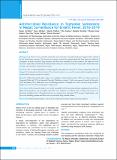Please use this identifier to cite or link to this item:
https://hdl.handle.net/20.500.14356/1078| Title: | Antimicrobial Resistance in Typhoidal Salmonella in Nepal: Surveillance for Enteric Fever, 2016-2019 |
| Authors: | Shrestha, Rajeev Adhikari, Navin Pradhan, Sailesh Amatya, Ritu Shrestha, Basudha Khadka, Dhruba Kumar Roy, Renu Pradhan, Rojika Tamrakar, Dipesh |
| Citation: | ShresthaR., AdhikariN., PradhanS., AmatyaR., ShresthaB., KhadkaD. K., RoyR., PradhanR., & TamrakarD. (2021). Antimicrobial Resistance in Typhoidal Salmonella in Nepal: Surveillance for Enteric Fever, 2016-2019. Journal of Nepal Health Research Council, 19(1), 162-169. https://doi.org/10.33314/jnhrc.v19i1.3497 |
| Issue Date: | 2021 |
| Publisher: | Nepal Health Research Council |
| Article Type: | Original Article |
| Keywords: | Antimicrobial resistance enteric fever multi-drug resistant Nepal Salmonella typhoid |
| Series/Report no.: | Jan-March, 2021;3497 |
| Abstract: | Abstract Background: Enteric fever (caused by Salmonella enterica) has been associated with poor hygiene and is endemic in the South-Asian countries. The increase in resistance to first line antimicrobials has been observed, while the emergence of multi/extremely drug resistance cases have been identified in several countries. The objective of this study is to analyze the current trend of antimicrobial resistance in Salmonella isolates in Nepal, and to identify the status of multi- and extremely- drug resistant isolates. Methods: We recruited individuals at study hospitals with suspected enteric fever between September 2016 and August 2019 and performed blood cultures. The Salmonella isolates were tested for antimicrobial susceptibility and the antimicrobial resistance trend was evaluated. Results: 1438 positive blood culture isolates were studied for antimicrobial resistance. 88% were culture positive for Salmonella Typhi and 12% for Salmonella Paratyphi. Multidrug resistant S. Typhi cases appeared mostly in December 2018 and January 2019, while there were no multidrug resistant S. Paratyphi cases. Also, extremely drug resistant S. Typhi cases were not observed during the study period. Conclusions: The Salmonella isolates were mostly susceptible to first-line antimicrobials, cephalosporins and others. Many fluoroquinolones non-susceptible Salmonella were obtained, nevertheless their overall trend seems to be declining. In addition, the S. Paratyphi total cases are reducing since September 2017. Among S. Typhi isolates, only few were multidrug resistant and there were no extremely drug resistant isolates. Keywords: Antimicrobial resistance; enteric fever; multi-drug resistant; Nepal; Salmonella; typhoid |
| Description: | Original Article |
| URI: | http://103.69.126.140:8080/handle/20.500.14356/1078 |
| ISSN: | Print ISSN: 1727-5482; Online ISSN: 1999-6217 |
| Appears in Collections: | Vol. 19 No. 1 (2021): Vol. 19 No. 1 Issue 50 Jan-Mar 2021 |
Files in This Item:
| File | Description | Size | Format | |
|---|---|---|---|---|
| 3497-Manuscript-21570-1-10-20210425.pdf | Fulltext Download | 459.88 kB | Adobe PDF |  View/Open |
Items in DSpace are protected by copyright, with all rights reserved, unless otherwise indicated.
